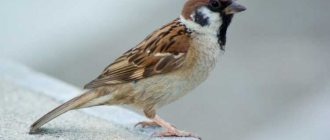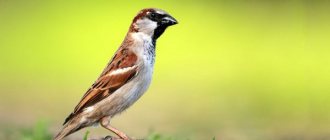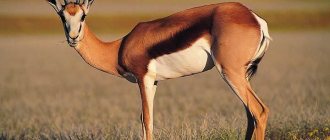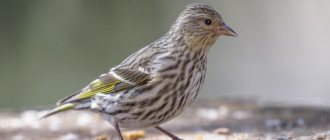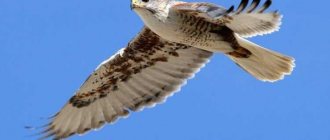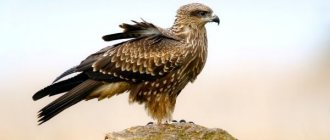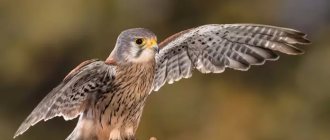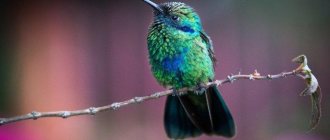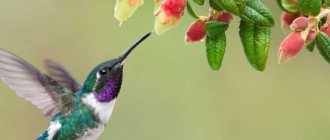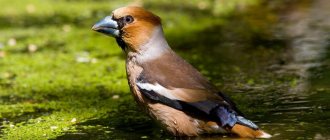- Wild animals
- >>
- Birds
The sparrow is a bird that every person has met.
This small bird has become an indispensable attribute of the trees growing in the yard, a herald of approaching warm days and impending rainy weather. Where the feeders hang, the ringing hubbub of sparrows is constantly heard, and with the approach of spring, their cheerful chirping can be heard everywhere. Little sparrows have become heroes of fairy tales, stories, sayings, nursery rhymes, proverbs and even folk superstitions. Let's take a closer look at the life activity of this small, but nimble and very famous bird.
Appearance
Photo of a sparrow
The colors of the plumage of sparrows include gray, brown and black. The abdomen is grayish-green, the head, back and wings are brown with white and black splashes.
Sparrows are distinguished by a cone-shaped beak, short rounded wings, and a truncated tail. The sparrow's legs are short, hairless, and have weak claws. The feather is dense and silky.
general characteristics
Sparrows are members of the passerine family. Their dimensions are about 15 cm, weigh 20-40 grams and have a wingspan of up to 27 cm. The birds are quite small, have a gray-brown color, with dark areas. The area around the head, belly and ears is painted in light colors.
Males are larger, and there is a bright dark spot in the area of their chest and chin.
Sparrows' eyes have a gray-brown edge. Their paws are short and thin, their claws are quite weak.
Male and female: differences
— Advertising —
Female and male sparrow photo
Sexual demorphism in these birds is manifested in feather color. Males have a black “tie”. The throat is also painted black. The head is dark brown. The beak is black.
In female sparrow birds, the head and abdomen are grayish with a slight green tint. The beak is gray, interspersed with yellow at the base. The feather color includes black and orchid ceta.
The female is usually smaller in size than the male.
Folk games
Folk game "Sparrow" (Russian folk game)
A very exciting game for children aged 5 years and older and even for adults. You can spend it on family trips or holidays.
First, choose a driver. It will be a sparrow. All other players must come up with what tree or bush they will be called. For example, some will be lilac, some will be birch, some will be rowan, etc.
All players except the sparrow sit in a circle. In the center of the circle you need to place a chair (stool or bench) for the sparrow. This will be a “column”.
Each player must loudly say to everyone who he will be in this game: “I am an aspen. And I'm an oak tree. I am a pine tree." Everyone needs to remember these words.
The little sparrow sits “on a post” and says rhythmically. The rest of the players sing along with him - they say sentences with him.
Chiv-chiv-chiv, little sparrow Sat and sat on a post, The sparrow flew and flew to the raspberries!
The player who called himself a “raspberry” in this game must pick up the song:
Chiv-chiv-chiv, the little sparrow sat and sat on the post. The sparrow flew and flew to the birch tree!
This continues until someone makes a mistake and says “on the column” or names a tree that is not in the game! When a mistake occurs, all players must quickly change places, including the sparrows. You cannot occupy a column!
Whoever is left without a place becomes a sparrow in the next game. He sits on the post and the game continues.
Folk game "Gardener and Sparrow".
This game conveys the character of sparrows - nimble and combative.
Of all the players, you need to choose who will be the Sparrow and who will be the Gardener.
All players stand in a circle and join hands. Nuts are placed in the center of the circle - in the garden (you can also put something else that represents seeds). A circle is drawn 10 steps from the garden. This will be a nest.
The round dance moves slowly in a circle, all players say rhythmically or sing:
Small sparrow. Gray, remote, scurrying around the yard, collecting crumbs; He spends the night in the garden and steals berries.
The sparrow runs into a round dance, takes one nut (or something else that denotes the sparrow's food: a seed, a dried berry, a ball, etc.) and tries to take it to its nest (Children raise their hands to let it pass). The gardener tries to stop him. He guards the sparrow and begins to catch it.
If the sparrow managed to run to the nest and put the nut in its nest, and the gardener did not touch it, then the Sparrow participates in the next game in its own role. If the gardener catches a sparrow and touches it, then the sparrow becomes a round dance, and the next player is assigned to its role. But before this, the caught sparrow must complete the gardener’s task - sing, dance, ask a riddle, read a poem, etc. After he completes the gardener’s task, everyone sings to him:
No sparrow can fly for ages, no pecking berries in the garden, no sitting on an oak stamen. And you, little sparrow, sit on the meadow, And you, little gray one, sit in a circle. Isn’t it time for you to get up and fly, and dance in our round dance!>
Game option: After several players have played the role of a sparrow, it is determined which of the sparrows brought the most nuts (berries, twigs, seeds) to the nest. He becomes the winner of the game.
Folk game "Sparrow". The most favorite!
This game is one of my favorite and most exciting and useful games for children. It can be used to teach anything. Unless... you just copy one version of it given in all the books, but look deeper into the content and see a new meaning and an endless variety of options for its implementation.
This game exists as a round dance. But like all folk games, it is unique and multifunctional, since you can play with any theme with kids and older children. And it’s interesting to play for children! To do this, when playing with children, you need to change words and come up with new actions, introduce new topics. For example:
- on the topic “who spends the winter how,” the sparrow saw “how tits dance,” “how a woodpecker flies,” “how a fox sneaks,” “how a bunny meanders,” “how bears sleep.”
- on the topic “Transport” a sparrow can see “how a tram rings”, “how a car drives” and “how a boat sails”, “how a helicopter flies”.
- on the topic “Man” - “how a child walks,” “how an old woman walks,” “how fellows walk.”
- on the topic “Professions,” the sparrow will see “how a builder builds,” “how a pilot flies,” “how a pastry chef bakes,” “how a teacher teaches,” “how a singer sings,” “what a weaver does.”
Children love to invent and come up with more and more new rhyming tasks for the game, which at the same time develops language abilities, creativity, and the ability to find new versions of familiar games themselves. Therefore, most often the game goes like this. You come up with the first three tasks in rhyme, and then one of the children comes up with a new verse, and we immediately sing the verse the child came up with. And then someone else realized it and suggested the next verse. You can come up with one at a time. This is a fun process of joint creativity with toddlers and older children! You can play together with your child, coming up with the following verses together. Another wonderful feature of this game is that although it is designed as a round dance, you can play it individually with a child, a subgroup, or a whole group, and conduct it as a physical education lesson. If this game is played as a physical education lesson, then the driver is not chosen, and all the children perform movements in a circle: everyone shows how a sparrow flies, and how young men, girls, and old women walk. You can come up with different movements. For example, young people can walk with their heads held high and their knees raised high. Or squat like a Russian dance. Girls can swim like peahens with their heads held high.
Here are the popular words of the game. Below, after the words, is an audio recording of her melody.
The sparrow flew and flew, the young sparrow flew and flew Across the blue sea - 2 rubles. Across the blue sea - 2 rubles. For a clear field - 2 rubles.
I saw, I saw the sparrow, I saw, I saw the young How the girls walk - 2p. And the girls walk like this - 2p. Here they are like this - 2 rubles.
The sparrow flew and flew, the young sparrow flew and flew Across the blue sea - 2 rubles. Across the blue sea - 2 rubles. For a clear field - 2 rubles.
I saw, I saw the sparrow, I saw, I saw the young sparrow How well done they walk - 2p. And the good guys walk like this - 2 rubles. Here they are like this - 2 rubles.
The sparrow flew and flew, the young sparrow flew and flew Across the blue sea - 2 rubles. Across the blue sea - 2 rubles. For a clear field - 2 rubles.
I saw, I saw the sparrow, I saw, I saw the young one How old women walk - 2p. And old ladies walk like this - 2p. Here they are like this - 2 rubles.
I am sure that you will also love this game and come up with many variations of it. Have you come up with your own versions of this game? Send it to the site, share in the comments!
Music for the game can be heard in this video.
Why was it called that?
Photo of a sparrow in flight
According to popular interpretation, the word “sparrow” arose from the phrase “beat a thief!” - once a little sly guy stole a bun from the counter, for which the seller began shouting “beat the thief!”
Science has a different opinion about the nature of the origin of the bird’s name. “Sparrow” most likely was formed from the Old Slavic word “gorobets”, which translates as “pockmarked” (the pockmarked color of a sparrow’s feather).
According to some sources, sparrows were so nicknamed due to the sounds they make “vrk vrk”. It is believed that the forgotten word “work” is related to such words as “coo”, “grumble”, “sparrow”.
Habitat
Previously, the habitat of the house sparrow was limited to Northern Europe. Subsequently, the species spread widely in Europe and Asia (with the exception of the Arctic, northeastern, southeastern and central Asia), as well as in North and East Africa, Senegal, Asia Minor, the Arabian Peninsula and even on the island of Java. Since the 20th century, the house sparrow was brought to different countries, spread widely there and currently, in addition to the places indicated above, also lives in South Africa, Australia, New Zealand, North and South America and on many islands. Almost everywhere it is a sedentary bird, only from the northernmost parts of its range it migrates to the south for the winter (up to 1000 km), and from Central Asia it flies to Western Asia and India. The house sparrow is widespread throughout Russia. Following human habitation, it penetrated far to the north into an unusual zone of forest-tundra and even tundra - to the Murmansk region, the mouth of the Pechora, and northern Yakutia.
Being a synanthropic species - a permanent cohabitant of humans, the house sparrow is well adapted to life in an environment that changes under the influence of human economic activity. The sparrow can equally be found in rural and urban areas, in settlements of the Far North and Central Asia. However, in Central Asia it usually stays away from humans. The wide distribution of the sparrow to the north and south following the expansion of arable farming is facilitated by its high fertility. The house sparrow leads a sedentary lifestyle, which is favored by nesting conditions and abundant food in human settlements.
In some southern regions of the country it causes serious damage to crops of grain and oilseeds; in the northern regions, the house sparrow is a useful bird that destroys garden pests.
Lifestyle
Flock of sparrows photo
Sparrows are not migratory birds. Sparrow birds lead a sedentary lifestyle and rarely leave their permanent place of residence. The offspring, having matured, remain with their parents until the end of their days. Birds form large flocks of hundreds of individuals.
Sparrows are by nature pugnacious, harmful creatures. Defending territory, they attack unwanted birds and animals in whole flocks. Even larger birds prefer not to mess with the impudent little ones. Sparrows are not averse to fighting with their relatives. They often fight over a female or a vacant nest. Calm, peaceful coexistence is unknown to them.
Sparrows sitting on a branch
Any event is accompanied by commotion, noisy sounds and, of course, a fight. In winter, sparrows behave calmer. In cold weather they sit in dense flocks on wires or bare branches of trees and sit with their heads ruffled, occasionally talking to each other. In summer, the sparrows cannot be appeased. From dawn to the last ray of the sun they chirp, rummage through garbage cans in search of food.
The average lifespan of sparrows is 4-5 years. Most birds die in the first year of life due to bad weather conditions and injuries (sparrow chicks often fall out of the nest).
Features of behavior
Photo of a red sparrow sitting on a rope photo
Sparrows are sociable, friendly birds. They live in close proximity to animals, other birds and humans.
True, noisy and fussy by nature, they do not always get along with swifts and tits. The latter often leave the territory where the family of sparrows is located - they cannot stand the impudent behavior of small mischief-makers.
It is known that sparrows have developed memory. It has been proven that they can form a logical chain of events. They are afraid of cats, but love to tease them by jumping on their short legs near her bowl. Sparrows feel right at home in the barnyard. They feed from the same feeder with chickens and ducks.
Features of character and lifestyle
Photo: House sparrow bird
Sparrows are impudent, arrogant, unceremonious and cocky. Where there are many of them, there is always noise, din, chirping, and chirping. Sparrows have a fighting character, a little impudent. Often they displace other birds from some territory.
Sparrows live in flocks, because their grown offspring stays with their parents, then the flock grows every year. The life span of a sparrow is short, it is only about five years; specimens that live up to 10 are rare. Family unions among sparrows are strong, created for the entire short life.
The sparrow is a sedentary bird, preferring to live in the same territory, because of which scandalous fights and stormy showdowns with strangers often occur.
A sparrow's nest can be found anywhere:
- on the balcony;
- in the attic;
- behind the window cornice;
- in a birdhouse;
- in a small hollow;
- in an abandoned swallow's nest.
The tree sparrow often moves into the nests of large birds (herons, eagles, storks, falcons). The cunning sparrow is thus protected by large birds, which watch over their offspring, while simultaneously looking after the passerine.
In the sparrow family, peace and quiet have never been heard of; there is always noise and restless chirping, especially in early spring, when newly-made couples are created. Each flock has a guard sparrow, which at its post vigilantly monitors the surrounding environment, warning its relatives of the slightest threat with its ringing chirping cry. Hearing him, the flock quickly scatters.
Sparrows are partly romantics, because... They look at the world through rose-colored glasses, that’s just the way their visual apparatus is structured.
Reproduction
Photo of a sparrow chick
are monogamous. At one year of age, females reach sexual maturity. Mating games for house sparrows begin in March. Mating is accompanied by constant fights and screams. By the end of March, passions subside, the newlyweds begin building housing. In April, the female lays eggs.
The clutch contains 5-7 white eggs with dark brown spots. Mature females lay 8-10 eggs at a time. Hatching takes 12-14 days. Sparrow chicks hatch at the same time. The skin of newborns is bluish-red, there is no fluff. Helpless sparrows are constantly hungry. The young feed on insects, fly larvae, and ant cocoons. Both parents are involved in feeding the offspring. The female and the male alternately fly up to the chicks and put pieces of living creatures in their mouths. By 17 days of life, sparrow cubs become adults and leave the family nest.
Sparrow eggs in the nest photo
During the season, a female sparrow manages to hatch 3-4 offspring.
sparrow nest
Sparrow nest photo
Birds make their homes in the cracks of buildings, under the eaves of roofs, in clay burrows, in thickets of bushes, and hollows of large trees. They love to occupy the houses of other birds - swallows, starlings. In the southern regions, sparrows build nests on tree branches.
Both the male and the female participate in the construction of the nest. Sparrows do not like to spend a lot of time arranging their homes, so in the photographs you can see that the nests are irregular in shape, with holes in the walls, made of dilapidated materials.
Birds build a home from straws, blades of grass, twigs, and dried leaves. The size of the ball nest is 10-12 centimeters in diameter. Depth – 6-7 centimeters. The bottom is covered with feathers and cotton wool. The entrance hole is made on the side at the top of the nest.
Nutrition
Sparrow feeds on living creatures photo
Sparrows feed on plant foods, supplementing their diet with insects in the spring, which also feed the chicks. The poultry menu consists of agricultural seeds, cereals, currants, grapes, and cherries.
In spring, it feasts on flower buds. In forests it feeds on seeds of wild grasses and insects.
What do they eat?
The adult sparrow initially preferred plant foods: grains, seeds, fruits and berries. Males carried small insects and worms only to females, and then both to feed the chicks.
Due to the fact that sparrows live side by side with humans for many centuries, they become omnivorous. They eat what people feed them when it’s cold. Mainly bread. They live in food dumps and eat any edible waste. You can read more about what a sparrow eats in another article.
The more cities become urbanized, the more the diet of the urban sparrow changes, because there are fewer and fewer trees, plants and insects.
The tree sparrow has retained its food preferences; it is a threat to gardens and fields. And if there are no crops nearby, then tree sparrows forage for food in the meadows and along the edges of the forest.
In spring, they can cause great damage to trees by pecking off buds. There are no fat reserves in the sparrow's body at all, so it must constantly feed.
The lack of food for a sparrow in winter is very dangerous. Hypothermia and hunger lead to rapid death. In summer, a sparrow also cannot be hungry for long - constantly wasting energy, it will die if it does not eat for more than a day.
Spreading
Area
Sparrow Population Map
is large. These nimble birds are found in Europe, Russia, and Africa. Some species were exported to America, Australia and New Zealand.
Habitats
Sparrows are classified as a synatropic species - they follow a person everywhere and everywhere. They settle in noisy cities and quiet villages, close to human habitation. Wherever they find themselves, sparrows will find shelter and find a home.
A man treats a sparrow
These birds can live in any weather conditions and easily get used to the environment created by people. By the way, sparrows live even where other birds cannot survive - for example, in the tundra and forest-tundra.
Where do sparrows live in the wild?
This is one of the largest populations of birds found in nature. Sparrows are considered indigenous to Eurasia, but at some point they began to spread throughout the planet. They can be found in Russia, the USA, Europe, Australia, and Africa. Birds adapt well to any conditions, except for very cold regions.
Elena
Ask a Question
Question to the expert
Why don't sparrows, like other birds, fly south?
This fact is due to several reasons, the main of which is the peculiarity of the distribution of sparrows that live near people. Other birds fly south during the cold season due to lack of food and the harsh winter climate, which they are unable to endure without food supplies. It is easiest for sparrows to get food near people, so they do not try to leave their natural habitat. Sparrows are accustomed to interacting with humans, they have learned to pick up leftover food and use homemade feeders. People give them not only food, but also shelter: many nests are made in existing buildings, under the roofs of houses, in attics. Therefore, most sparrows live their entire lives in the place where they were once born. In addition, the sparrow’s body is designed in such a way that its anatomical features simply do not allow it to fly to another region. Birds have rather small wings and a dense body that is poorly adapted to prolonged physical activity.
Sparrows settle everywhere near humans. It doesn’t matter where people live: in big cities or quiet villages, these birds will always be nearby.
Keeping House Sparrows
House sparrow sitting on a branch photo
It so happens that sparrows are not kept at home. The only reason why these birds fall into human hands may be feeding a chick that accidentally fell out of the nest. It happens that a person, wanting to help the bird, decides to take the sparrow home with him. But you should know that a chick on the ground is not always in danger. If the baby is feathered, it means it is a fledgling, that is, a chick that is learning to fly. His parents are probably circling somewhere nearby. But a completely naked chick lying on the ground is in danger. It could be eaten by predators or freeze to death. This baby needs to go home and try to go out.
In fact, sparrows feel comfortable both in large cages and in aviaries. They quickly get used to captivity and behave calmly. Sparrows are kept in small groups in spacious enclosures.
The tree sparrow feels the worst in captivity. Brownies are more accommodating. Stone sparrows are the easiest to keep. They are less aggressive and quickly get used to their surroundings.
Sparrow cage
House sparrow lives in a cage photo
Exotic species of sparrows are also kept in aviaries. Snow finches, heat-loving golden or saffron sparrows, yellow-bellied or weaver sparrows are kept as pets.
It is important to keep the sparrows occupied, then there will be no problems with them. For this purpose, the houses are equipped with numerous perches and branches. You can even plant a small shrub or throw in some dry driftwood.
Sparrows love to swim. Therefore, a large bowl of water or sifted sand is placed in the corner of the cage. For drinking, it is better to use closed containers. The water in it should always be clean.
Benefit or harm
There is no clear answer to the question whether sparrows are beneficial or harmful. Sparrows primarily destroy pests and save trees. And that’s why in cities they are often protected. But sparrow raids on crops and gardens can completely destroy the crop.
The proximity to sparrows forces people to fight them if there are too many birds. On the other hand, in cities they need to be protected and fed. After all, apart from sparrows, there are almost no insectivorous birds left that eat beetles and caterpillars. Watch a video about a beautiful sparrow.
How to come out of a sparrow
A man nurses a sparrow photo
It is difficult for a newborn sparrow chick to emerge. Firstly, he is not yet feathered, which means he can quickly become hypothermic. Secondly, he also doesn’t know how to feed himself. During the first days, the baby is kept in a small cardboard box, lined with paper napkins or toilet paper (to build something like a nest).
The chick should be kept in diffused sunlight, in silence. Every half hour - a meal. A baby sparrow eats 13-17 grams at a time. After feeding, wipe the beak with a dry cloth - this will protect it from the development of infections.
What to feed sparrow chicks
A sparrow chick in a person's hand before feeding photo
If you took pity on a sparrow chick that had fallen from the nest and took it in, then it is important to know how to properly feed the chick. Newborn chicks are fed a liquid feed mixture. Porridge made from boiled eggs, wheat, grated carrots, and lettuce is well absorbed by the fragile body. All ingredients should be mixed in a blender to a liquid consistency. Food is given from a pipette.
At the same time, the chick may jerk its head and scream heart-rendingly, but the bird quickly gets used to the tenderness and care and after a few days remains more calm in captivity.
You can make a sparrow grow faster by adding as many insects as possible to its diet - grasshoppers, crickets, caterpillars, butterflies. Every time after eating, the chick is given water to drink and the nest is cleaned of droppings.
House Sparrow in the Red Book
Sparrows were included in the Red Book of England. Let's find out why.
Main causes of extinction
The reasons for the decrease in the species population in urban areas are the following factors:
- infrastructure development;
- use of green areas for parking and construction of facilities;
- strong city noise;
- air pollution;
- electromagnetic radiation from high-rise buildings.
All this disrupts the navigation abilities of sparrows.
In India, World Sparrow Day is celebrated on March 20th. The number of the species in this country is declining significantly.
The mass death of birds is provoked by difficult living conditions. Young animals sometimes do not survive until spring due to harsh and snowy winters. The death of babies is caused by the frequent loss of chicks from their nests.
Experts believe that the decrease in numbers is due to the peculiarities of modern architecture. Previously, birds settled in the nooks and crannies of buildings. Today, cities are being built up with buildings with smooth walls, where there are no holes, and attics are becoming glazed attics.
Ornithologists say that sparrows do not have enough natural food for their chicks. Artificial and mowed lawns are meaningless for them in terms of food production. There are no caterpillars or beetles to be found there.
Current population situation
Today you can rarely see sparrows in large cities. Things are better in the provinces. In some areas, the number of sparrows is stable. According to various sources, in European countries there are from 60 to 200 million birds. There are over 30 million of them in the Russian Federation.
The number of sparrows began to decrease in the second half of the last century. In England, the number of individuals has decreased by 2/3, and the trend currently continues.
There are special companies that deal with the destruction of sparrows. Firms involved in the collection and sale of grain turn to such organizations. A large volume of raw materials is lost due to feathered predators. In a year they eat as much as 35 million people could eat.
Do you need to take protective measures?
Sparrows are very active in the winter season and constantly empty feeders. Those who want to save little birds need to prepare a treat for the birds in the form of sunflower seeds, unsalted lard, and bread crumbs. Sparrows need these products in cold weather. You shouldn't add rice, just like rye bread.
Feeders should be hung on trees in the park and yard. It would be a good idea to take care of a drinking bowl for sparrows. In winter, they are also thirsty, and it can be difficult to get water.
Sparrow feeding at home
Sparrow found a piece of bread photo
The long life of a sparrow as a pet depends on the quality of food and living conditions. What to feed a house sparrow? Complete fortified food! Stores sell cereal mixtures enriched with vitamins and minerals; they are fed to the birds every 1-2 hours.
In addition to cereals, the chicks are fed boiled eggs and raw meat. Part of the diet consists of food of animal origin. Insects for feeding chicks and adults should only be fresh (live). Poultry is pampered with grated fruits and vegetables.
How long do Blackbirds hatch eggs?
Almost everywhere, song thrushes have two clutches per year: the first in late April - early May, the second in June. The first clutch consists of 5-6, the second - of 4-5 blue eggs with small brown spots. The eggs are incubated by one female for 12-13 days. Both parents feed the chicks, flying to the nest with food 150-200 times a day.
Interesting materials:
How many foreign languages does Zhirinovsky know? How many foreign languages did the writers know? How many peoples and languages are there on earth? How long does it take to study to become a Russian language teacher? How many native English speakers are there? How many nasal sounds are there in French? How much study do you need to learn a language? How many official languages are there in Nigeria? How many cases are there in German? How many cases are there in English?
What to feed a sparrow in a feeder
A flock of sparrows gathered at a feeder photo
In winter, sparrows fly to a person's house in anticipation of being fed. People believe that sparrows can be fed with bread crumbs. But flour products are harmful to the digestive system of birds. It is recommended to feed birds with cereals and seeds. The seeds must be raw. Pieces of lard are a necessary protein for the full functioning of the bird's body.
Features of the sparrow bird
Sparrows like to settle closer to humans. In cities, flocks of these birds gather on wires, tree branches, and in places where they can get more food. People are so used to their presence that they simply don’t notice.
In addition, sparrows are not very large individuals. On average, their body length reaches 10-15 cm. The weight is ridiculous - 30 g, no more. The wingspan alone is impressive. It is about 30 cm.
Interesting Facts
Male sparrows in a fight photo
- The sparrow's eye sees everything in pink.
- The number of cervical vertebrae in a sparrow is twice that of a giraffe.
- A baby sparrow is popularly called a “yellowthroat” (due to the yellow color of its mouth). In colloquial speech, “yellow mouth” means a young, inexperienced person, a teenager.
- There is a red sparrow in nature. However, this bird has nothing in common with real sparrows. Its other name is lentil and it belongs to the finch family. The size of the lentil is similar to the sparrow, and the color of the feather is bright red.
- The homeland of sparrows is Southeast Asia.
- The passerine population consists of 1 billion individuals.
- Sparrows can fly for no more than 15 minutes.
- The diet of young sparrows consists of 1000 different insects
- The sparrow's body temperature is 44 degrees.
- Short legs do not allow the sparrow to walk, so it jumps.
- People say “The word is not a sparrow; if it flies out, you won’t catch it.” The word is compared to a bird, that is, thoughtless words can fly out and offend a person. You should think carefully before opening your mouth.
Nutrition
Sparrows eat everything in the literal sense of the word. They don't have any special preferences. They eat insects, grain, crumbs, human food waste. These birds are not particularly modest. They can sit and brazenly look into the mouth of a person who is eating at a table in an outdoor cafe.
If you remain motionless in this case for some time, the bird can safely climb onto the table and grab what attracted its attention. The slightest movement causes the bird to flee. Birds do not have greed for food. The whole flock flocks to the tasty morsel, after which the feast begins.
Unfamiliar food is tried with great caution. Summer time is especially good for country sparrows. In the village they simply have a huge abundance of food. Moreover, the scarecrows built by people in the garden to scare away birds are absolutely not scary for sparrows.
In addition to this food, sparrows also feed on caterpillars and other harmful insects, which in large quantities can cause irreparable harm to the national economy.
Signs about sparrows
Sparrow sitting on a support photo
Among the people, sparrows are considered harbingers of misfortunes and large-scale changes. Esotericists believe that the soul of a deceased person flies with a sparrow, trying to communicate about impending changes in people’s lives.
If a sparrow flies into the house, then the owner is in for news that will greatly surprise him. A sparrow entered a home through a window - a person will face troubles at work and at home. For example, equipment breaks down, a faucet breaks, or neighbors flood. A sparrow knocks on the window - pay more attention to pressing matters, otherwise you will fail. If a sparrow hits a window, then this sign indicates that there is a need to resolve complicated matters on which one’s career or family well-being depends.
Sparrows bathe in a puddle - what is this for? Our ancestors also explained this behavior of birds by the fact that if a sparrow splashes in the water, it means that a dry season is coming. If there is no rain, there will be no harvest. That is, the bathing of sparrows was associated with grief, hunger, and pestilence. Now this sign also has a negative connotation: if a sparrow bathes in a puddle, expect trouble.
Seeing a sparrow in a dream is a sign of impermanence and uncertainty. If you had a dream in which a sparrow died, in reality a person will face serious troubles. A sparrow in a cage means a serious illness. Hearing a sparrow tweet means encountering an obstacle on the way to your intended goal.
Population and species status
These birds can be found in large numbers anywhere in the world, so it is almost impossible to meet a person who has not seen a sparrow in his life. Sparrows are not included in any Red Book. The benefits of these birds are simply enormous, although many, as a rule, do not notice this benefit, but note the great damage caused by the birds.
The fact is that sparrows destroy many harmful insects, but in the summer, when there are many of them. With the onset of autumn, when the air temperature drops, many species of insects disappear and it is not so easy to find them. Therefore, sparrows are forced to switch to other food - plant food, which in the fall is abundant in vegetable gardens, orchards, farm plots, etc. As part of numerous groups, they carry out raids on gardening crops, as well as on farms, as well as on territories where grain of various crops is stored.
Important point! Fighting sparrows is not so easy, especially since there are quite a lot of them, and they are not afraid of various mechanical rattles and scarecrows placed in vegetable gardens and summer cottages. At the same time, we should not forget that these harvests were obtained thanks to the enormous benefits brought by these birds. Thanks to the daily, enormous work of these birds, it was possible to avoid attacks on the crop by numerous pests.
Quite a lot of time has passed, so few people remember the incident that happened in China with sparrows. The Chinese decided that the sparrows did not allow them to get the lion's share of rice by eating it, and they decided to destroy the sparrows. Moreover, this was done at the government level, since bonuses were even provided for those who destroy the most birds. Knowing that these birds could not fly for more than 15 minutes, they did not allow them to land and they simply fell to the ground dead, from exhaustion of strength and energy. It would seem that the problems with the crops were solved, but they were mistaken, because pests multiplied in huge numbers and ate almost the entire crop. As a result of the ensuing famine, several tens of thousands of people died in China.
When they realized what awaited them next, they had to import these birds from other countries. Even this incident shows how useful these birds are.
Voice
Photo of a sparrow in flight photo
The sounds made by sparrows bear little resemblance to a folding song. Rather, these are short, incoherent screams that are more like signals. The voice of house sparrows is loud and rough. The timbre is low. The sounds contain hard voiceless consonants. The chirping of field birds is gentle and euphonious. In the ligaments you can hear “chii”, “chiyui” “shchui”.
The rock sparrows have a different voice from other sparrow species. They make drawn-out, creaky, dull sounds “viip”, “tsuii”. The repertoire of the stone sparrow includes short sounds - “chip”, “tweet”, “tewie”. Sounds are made separately or in short series - calls.
Photo of a black sparrow sitting on a branch in winter
The voice of the black (black-breasted) sparrow is melodic and has a high timbre. The sparrow makes hissing, drawn-out sounds “chvil”, “chili”, “chii”. The song consists of repeated sounds “chuit-chuit-chuit”.
Photo of a finch
The sounds of the snow finch are euphonious. Voiced, catchy, abrupt “priik”, “truk” are replaced by drawn-out “psiu”, “pchii”. During the nesting period, the finch emits joyful chirping calls “pitty”, “tirri”, “tirrip”. A set of sounds forms a trill, which lasts 2-4 seconds.
Types of sparrows that exist on the planet
In nature there are a huge number of birds similar in appearance to the sparrow, but they have nothing in common with it. Scientists have identified only 22 species of sparrows, eight of which are the most common. The brownie and the field live everywhere. Besides them there are:
- Snow sparrow. It is found in Altai, on the territory of the Caucasian republics.
- The black-breasted or black sparrow is common on the African continent, less common in Eurasia.
- Red birds, also called red sparrows, settled in the Kuril Islands and Sakhalin.
- The stone sparrow lives in the Transbaikal region, Altai, Caucasus, and Volga region.
- The Mongolian type can be found in Tuva and Altai.
- Shortpaw lives in Dagestan.
Calls, nursery rhymes and teases about the sparrow
Introduce the kids to the folk chants that are chanted when they see sparrows on the street. Say rhythmically:
Sparrow, sparrow! Don't chase the pigeons! Don't bite the sand, Don't dull your sock! A sock on a spike of oats will come in handy.
Not all children understand what the words “don’t tip your toe” mean in this chant. Therefore, ask the kids why it is impossible for a sparrow to “stub his nose - sock” and explain that here the sparrow’s beak is called this word. And his beak will also be useful for pecking oat grains.
The first time, say the nickname yourself, and then the baby can finish the last words after you in rhyme: “A sock will come in handy for oatmeal...? (Spikelet!)"
Sparrows were teased like this:
Tweet-chir-sparrow! Peck, peck hemp! Crack - food, bring hemp!
Chio, chio, whew-whew-whew! Chiki-chirik! Whose-whose-whose! Chin chin more! Chin chin more!
Another nursery rhyme about a sparrow for the little ones, the reading of which is accompanied by the movements of the baby’s hands.
The sparrows flew into the garden (we wave our hands). They ask: “Whose peas? Whose peas? (turns head left and right) Dima (child’s name) says: “My peas! My peas! (pointing to oneself with palms) The sparrows say “Chivi-chivi-chivi!” (turns head left and right) Dima says: “Shoo! Shoo!” (driving movements with palms) Sparrows: “Prrrr! They flew and sat on Dima’s head!”
Stories about a sparrow for children.
Without words (N. Sladkov)
- Why are they, fools, afraid of me? - asked Lucy. -Who is afraid of you? - I asked. - Sparrows. Sparrows were jumping in the park. Lucy threw crumbs at them, and they flew away in fear. - Why are they flying away? - Lucy was surprised. The girl asked me a riddle! Indeed - why? I didn’t think about it before: they are afraid and afraid. That's why they are wild birds. But the girl wants to feed them, the sparrows are hungry, but they fly away. Why? - Why are they afraid of me? I never offended them! - says Lucy. “It’s not your fault,” I reassure her. - Who is to blame? - We are to blame. That's all. Some - because they always offended the birds, others - because they allowed them to be offended. - But why offend them? They’re small... “Nothing,” I said to Lucy. - You throw and throw crumbs at them, and they will understand that you are their friend. - Do you think they will understand? - They will certainly understand! After all, they understood that they had to save themselves when stones were thrown at them. “I’ll tell them that I don’t throw stones, but crumbs!” “You don’t need to say anything, Lucy.” They will understand without words. - Without words? And I thought they were fools! - said Lucy. The birds understood Lucy.
Sparrow (Evgeny Charushin)
Nikita and dad went for a walk. He was walking and walking and suddenly he heard someone chirping: “Chilik-chilik!” Chilik-chilik! Chilik-chilik! And Nikita sees that it is a little sparrow jumping along the road. So ruffled, just like a ball rolling. Its tail is short, its beak is yellow, and it doesn’t fly anywhere. Apparently he doesn’t know how yet. “Look, dad,” Nikita shouted, “the sparrow is not real!” And dad says: “No, this is a real sparrow, but only a small one.” This is probably the chick falling out of its nest. Then Nikita ran to catch a sparrow and caught it. And this little sparrow began to live in a cage at our house, and Nikita fed him flies, worms and a bun with milk. Here is a sparrow living with Nikita. He screams all the time and asks for food. What a glutton! As soon as the sun appears in the morning, he will chirp and wake everyone up. Then Nikita said: “I will teach him to fly and release him.” He took the sparrow out of the cage, sat it on the floor and began to teach. “You flap your wings like this,” Nikita said and showed with his hands how to fly. And the sparrow jumped under the chest of drawers. We fed the sparrow for another day. Again Nikita put him on the floor to teach him to fly. Nikita waved his arms, and the sparrow flapped its wings. The sparrow has flown! So he flew over the pencil. A red fire truck flew over. And when he began to fly over the inanimate toy cat, he bumped into it and fell. “You’re still a bad flyer,” Nikita tells him. - Let me feed you for another day. He fed and fed, and the next day the sparrow flew over Nikitin’s bench. Flew over a chair. Flew over the table with the jug. But he couldn’t fly over the chest of drawers - he fell. Apparently, we still need to feed him. The next day Nikita took the sparrow with him into the garden and released it there. The sparrow flew over the brick. Flew over a stump. And he began to fly over the fence, but bumped into it and fell. And the next day he flew over the fence. And flew over the tree. And flew over the house. And he completely flew away from Nikita. That's how great it was to learn to fly!
